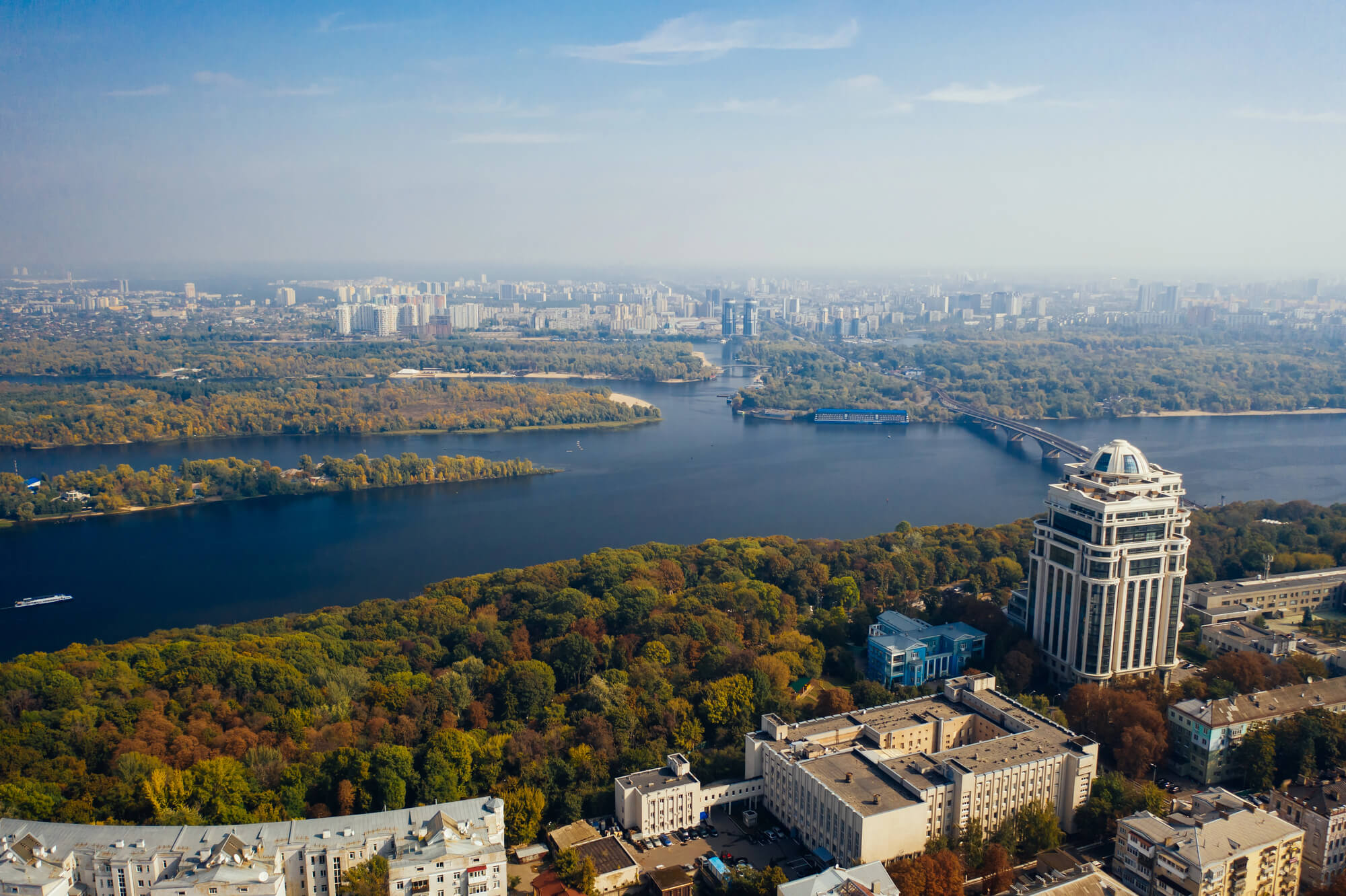Is a country the sum of its cities and regions? Should we align development strategies across different geographical levels and if yes, how to start thinking about this? This article suggests that a proper identification of the economic base of Ukrainian regions is a necessary initial step for designing and delivering a sustainable post-war reconstruction. Needed inputs are high quality and timely data on urban and regional socio-economic processes. Implementation and impact evaluation can be sustained via digitalization. Macroeconomic policies will benefit from taking into account regional production and international trade profiles.
How to coordinate reconstruction at different levels?
The process of post-war reconstruction has an essential urban and regional element. Economic development of villages, cities and regions is analyzed with an overlapping, complementary yet partially different methodological and intellectual lens than growth in macroeconomics. This is important as different national development strategies put emphasis on different mixes of labor and capital, with wide implications in terms of productivity, financing needs of firms and subsequent wage and profitability dynamics. For example, a development strategy focused on knowledge intensive industries will require a close network of highly skilled workers. These can mostly be found in urban areas, where proximity enables frequent face-to-face exchanges. Contrast this to a traditional industrial development strategy where a capital-intensive production facility may be located in the countryside, without an equivalent need for high skilled labor inputs but large initial fixed capital outlays. These different choices imply different paths of labor and capital input and thus different wage and rent profiles. Subsequently, the success or failure at regional level will be reflected in aggregate statistics and implicitly affect the macroeconomic context.
Work-life balance at city, region and country level requires careful planning
Ukrainian cities adopted many urban innovations from Western Europe and the US without having a long-term blueprint on urban development. This brought shiny commercial and comfortable residential real-estate solutions inserted in otherwise fragmented post-soviet landscapes which did not consider the new challenges they would pose to city management. Lacking the ability to adapt to the new realities, large Ukrainian cities found themselves clogged by traffic and chaotic parking, infrastructure unable to keep up with the increased number of residents and real estate development fully detached from the surrounding communities. Smaller cities witnessed dwindling numbers of residents and firms. Unbalanced regional growth was already an empirical fact before the war. Post-war realities will only accelerate social and economic processes that were lacking clear, coherent solutions. In this context, a proper assessment of post-war challenges in urban and regional development will be necessary to support socially inclusive and economically sustainable communities. An essential element of a successful reconstruction strategy is the harmonization of macroeconomic policies (taxation, subsidies in labor and capital markets) with their regional and urban counterparts (industrial policies, energy, transportation, and logistics).
Cities will need thriving, dynamic firms in emerging industries. Will they be financed by the traditional banking sector or perhaps via crowdfunding platforms? Will legislation encourage easy entry and exit into various markets and smooth defaults in case of insufficient commercial success? Is it better to have a robust SME ecosystem or a few large and productive dominating companies, or maybe both? Labor markets will be structurally transformed by a mix of long-run factors such as migration and aging, along with fast-paced external priorities.
The question on the economic model has answers at all geographical scales. Planning for an economy exporting services requires thinking about the complex mix of needed labor inputs, potentially distributed across wide geographies. Industrial parks and tax breaks may be enough to attract both firms and specialists in the first stage, yet high-value added innovative products and services have their roots in shabby garages. Additional constraints are the result of firm-recollection programs from the eastern and southern oblasts. There are no easy, immediate answers which ease short-term pressures without sacrificing long-term growth potential. But a proper framework to tackle the increasing list of post-war priorities is needed. One which formally recognizes the new macro-stability and urban development objectives and constraints and acknowledges that these objectives might not always be fully aligned. Distinguishing probable and achievable from economic chimeras is the first essential step towards a transparent, sustainable reconstruction effort.
Cities and Villages of Ukraine – the pre-war economic context
Already prior to the full-scale Russian invasion, a fracture in the quality and composition of economic activity in rural and urban areas was becoming visible in Ukraine. High value-added service industries (knowledge intensive, export oriented) benefit from a dense network of skills and a diverse labor market available currently only in highly urbanized areas. This outcome is reflected in other European countries too. Both EU and US cities compete to attract knowledge workers employing a wide range of strategies – from encouraging vibrant cultural scenes, walkable centers to targeted kindergarten subsidies and colorful playgrounds carefully inserted in high density residential areas. The IT industry, the engine of Ukrainian service exports, opens the doors of its offices mainly in cities. This is simply the result of economies of agglomeration. Knowledge workers are more productive in dense networks of complementary skills. Proximity to urban areas makes these networks possible.
Over time, these processes become self-sustaining and lead to an increasing density of firms and households. High rents for both office and residential real estate are then a natural outcome. When concentration leads to unaffordable costs, companies and workers will be pushed outside of the city core, leading to a re-equilibration of economic costs in cities and increased activity outside the core. But this centrifugal force expelling residential and commercial development will not damage the ecosystem only if adequate infrastructure allows workers to commute hassle free back to the core. Good quality services (health, education, retail, and entertainment) available close to their homes further add to the sustainability of such developments. This feedback loop takes time to play out, and targeted policies are needed to maintain a balanced development of the city. Lacking a clear vision on how cities and regions should grow, if given the opportunity, leads generally to unruly development which satisfies immediate needs at the expense of longer-term sustainable growth.
Real Estate Development
Our recent experience in Kyiv prior to the war shows that chaotic development puts emphasis on car-centric neighborhoods. Traffic clogged the city as well as major arteries in and out. Productivity is suffocated by idle time spent in traffic jams. Many residential complexes, if we consider for example Kyiv, turned out to be the dream of hyper functionalists. Real estate development was primarily about fulfilling the immediate housing need, but not really about the needs of urban dwellers over their entire life cycle. Just like after World War II, satisfying housing needs was the priority. And housing was delivered, but not functional neighborhoods. From Tallinn to Sofia, “Khrushchevkas” are the legacy reminding us of what happens when the housing question is answered from a too literal perspective.
The new real estate developments dotting the Ukrainian urban landscape, a bit insular in their reach for the sky in small groups of high-rises, would work wonderfully if incipient communities were built around them. These would be vibrant city quarters, with arts avenues, buzzing bars and small workshops. But these new developments were often built as fashionable appendices to the big-city, with little or no regard of how time is spent on their premises beyond a short walk-the-dog experience. Any traveler to and from Boryspil will notice them. These were built as open-air dormitories, very similar in spirit to the older urban practice.
As a functioning micro-neighborhood is expensive to build, understandably the focus was on producing new, well-designed, and built apartments but not necessarily new, well-designed, and built neighborhoods. What is the outcome? Residents commute to their apartment to sleep and shower and then commute back to the city for culture, food, events. Time spent productively talking about a new venture or product is replaced by time spent in traffic occasionally scrolling through social media.
Naturally, formulating and deploying a comprehensive development strategy to support a new district may not be the primary interest of the developer as the organic, multi-decade forces leading to growth of an urban area are not the same as those expecting a profit within the year. City halls and mayors enjoy the benefits of new development, bringing in better earning residents, but consider too little the associated additional pressure imposed by these on the existing infrastructure. Or the interdisciplinary nature of effective urban solutions. A more harmonious development of public transportation and upgrading of water, electricity, and sewage systems, in conjunction with the expected increase in urban density, will make life more enjoyable and firms more productive. The more private activity and public governance dance out of sync, the further high value-added firms and individuals emigrate. First between regions, then out of the country. Add additional frictions caused by less-than-optimal city governance and the occasional scandal and suddenly, neither subsidy nor low interest rates achieve their intended goal.
Rural Priorities and Regional Profiles
Rural areas, deprived of well-paid jobs and profitable industries, may become prisoners of long-gone economic models. At this geographical scale, it will be the role of regional development strategies to intervene and better sustain new modes of production and trade. This will come with the realization that manufacturing in the age of global value chains may connect a small community in Ukraine with a large auto factory in Germany thanks to the intermediaries they produce. This may change the attractiveness of such regions and boost employment.
Here we find multiple contact points where a macroeconomic strategy directly interacts with regional policies: via taxation of labor and capital income and their effects on skills composition of the labor markets, legislation encouraging entrepreneurship, a mature capital market able to distinguish different risk profiles and allocate capital accordingly.
Post-covid and post-war, many European companies understood the vital importance of flexible production and geographical proximity. As Central European economies already face increasing labor costs and rents, this abrupt re-organization of large production and distribution chains presents a unique opportunity for Ukrainian regions.
Economic Development Strategies
Changing consumer tastes and evolving market structures are realities that all firms are facing today in both developed and developing economies. Globalization is a two-way street which offers a world of opportunities to local companies that can import higher quality intermediary inputs at better prices while exporting their products to a new range of customers and markets. But globalization also subjects Ukrainian companies to more intense competition. More importantly, in developing a medium-run growth strategy, it is competition of a different nature than what is locally observed. An example will help clarify this point. Ukrainian agricultural output is primarily sold in the form of unprocessed (or little processed) grains and vegetable oils. Value added is relatively low and highly dependent on price volatility in international markets. At the same time Ukrainian supermarkets offer a rather limited range of locally produced biscuits and pastry. The road from grains to biscuits is not as complex as the one going from iron ore to an automobile or airplane engine, but the challenges share some similarities.
As a thought exercise, we can consider what is needed to develop a successful range of Ukrainian pastries (and more generally, cereal-based food products). One so successful that we can also use it as a channel to export grains at higher added value – as is the case with Italian pasta, for example. Machinery to produce them can be imported, but should we finance the capital acquisition with a hryvnia loan or perhaps a lower rate EUR loan? Furthermore, what kind of biscuits do customers really want? What do people appreciate in a biscuit – is it the combination of whole grains (to support their newly found healthy lifestyle) or perhaps the use of sustainable agriculture and green energy inputs? Would we have locally a company which can certify the wholeness of the grain or the greenness of energy? How much would customers pay for it? If we agree these are important questions, the next stage is to decide how to gather answers. Shall we use focus groups? Or perhaps reverse-engineer customer preferences using social platform interactions?
This highlights the important differences in competition nature – do local producers have the internal firm capability to process thousands of social media clicks to understand what color scheme to use for packaging? Do they actively develop their marketing strategies, distribution channels and risk-management skills? These simple questions point towards the immense work needed to get local firms ready for a competitive global economy. This is the different nature alluded to above – competitive products are the reflection of competitive firms. Firms which skillfully combine modern production processes (such as Just-in-time production), financial risk management while fully leveraging digital marketing strategies.
To successfully export our cereals at higher added value, we need to mix them with increasingly complex know-how ranging from foreign consumer tastes to supply chain management and financial markets. And more importantly, in the background, the macroeconomic context (the EUR vs UAH loan example boils down to interest rate costs and expected FX rates) needs to actively adapt to the new economic profiles of regions and cities. These will be done by enhancing the analytical capability of government bodies, enabling them to better understand the underlying drivers of observed economic and financial dynamics and hopefully also enabling them to design and implement scale-optimal interventions. It will also be done by enlarging the toolbox of policy makers to accommodate potentially diverse profiles of risk that have to coexist in the early stage of reconstruction. This may be, for example, different risk allowances for bank credit in different regions and industries, or equally important, tax and subsidies profiles flexible over time and space or conditional on particular outcomes.
Proper financing mechanisms, which do not pressure the fragile post-war financial stability of the banking system, are necessary but not sufficient. For example, a new tractor may help achieve greater yields in agriculture. But if we have fragmented land ownership with many small size estates, those benefits will not be easily realized. To reap the benefits of new capital, we also need innovative legal and social sharing mechanisms for these many small owners to aggregate for common objectives, such as leasing the tractor. Dedicated digital platforms, developed by local IT whiz-kids, may provide an answer not only to coordination problems in assembling capital and labor inputs, but also in selling the final products.
There is a non-trivial interaction between macrostabilization policies (inflation targeting and exchange rate smoothing) and firm specific growth strategies. The costs of a weak local currency are very well known. But an unreasonably strong local currency also has its downside as it invites potentially speculative cross-border capital flows. Some may bet on local tech companies or on replacing antique industrial capital vintages; some though might finance sectors with little productivity-enhancing potential. The housing boom and busts of many CEE countries, fueled by cheap EUR and CHF mortgages, stand testimony to this risk. The risk Ukraine will face head on once reconstruction begins via large and volatile capital flows adding a new source of volatility to the FX rate and requiring possibly larger scale interventions.
This interaction will become visible during the early stage of reconstruction. It is reasonable to expect a shortage of construction materials and workers. Before Ukrainian companies can produce everything needed for the construction industry, imports will fill in the gap. These imports, if not balanced by exports, will put pressure on currency reserves and the FX rate and possibly lead to inflationary flares. The most likely outcome will be an increase in the interest rate if the higher inflation is assessed to persist. But this would make capital more expensive at a time when it’s needed the most.
A durable post-war reconstruction will require a fundamental reassessment of constraints and resources, much more emphasis on innovation (across all domains of government and economy) and new planning principles. Social and environmental sustainability are core pillars of developed industries and the main guidelines of the Build Back Better strategy. Carbon-embedded taxes will severely penalize our industrial exports if Ukrainian firms do not upgrade their technologies. Such considerations sew together threads of national and regional policies, urban and rural infrastructure constraints, public and private interests.
Many actors will be involved in the reconstruction process, including state agencies, developers, international donors, and society. There is great potential, but its successful achievement will fundamentally depend on properly assembling old industry and new services shard pieces in a novel economic mosaic.
Making the total greater than sum of its parts – three priorities
Improving transparency and data availability
One of the first challenges currently encountered in urban development in Ukraine is the relative lack of high-quality data related to social and economic activities. Fragmented, disparate sources are available at regional and city level, yet these need to be assembled, documented, tested and eventually aggregated in a database that may be opened for future analysis and research.
Lack of data means a limited ability to understand where we stand in terms of regional industrial profiles, distribution of productivity across firms or the mix of labor and capital. Open-source data, such as social media activity and the emergence of high-quality low-cost satellite imagery, in conjunction with machine learning segmentation and categorization algorithms, open new investigation avenues that will extend beyond assessing war damages.
Assessment and identification of the economic base of Ukrainian regions and cities
What is the optimal industrial development strategy for existing cities? Existing models and theories can guide optimal economic redevelopment, highlight cost and benefits of various policies, their associated timelines and inherent uncertainties, but only subject to sufficient depth and quality of data inputs. A preliminary analysis of the existing economic base (broadly understood to encompass firms, human capital, and quality of local institutions) will provide an important starting point for the discussion on reconstruction priorities and their implementation.
Digitalization as a reformer of institutions and an enabler of markets
A reliable legal system underpins healthy markets and allows transparent and fast acquisition and dispositions of assets. Disputes during usage or at any other stage of the investment need to be efficiently resolved. The launch of the land title market is a positive recent step, reform of courts remains a broader challenge. The competitive structure of key market sub-segments needs to be improved: construction, finance, analysis and consulting, each benefit from low entry barriers and honest competition practices. Initiatives related to the reform of urban management are most needed. The recent frictions caused by the bill 5655 caution against insufficiently considered public priorities. Digitalization can and should play an essential role in accelerating the birth of the entire ecosystem of firms while also improving the functioning and accountability of existing state institutions and public bodies.
Attention
The author doesn`t work for, consult to, own shares in or receive funding from any company or organization that would benefit from this article, and have no relevant affiliations



